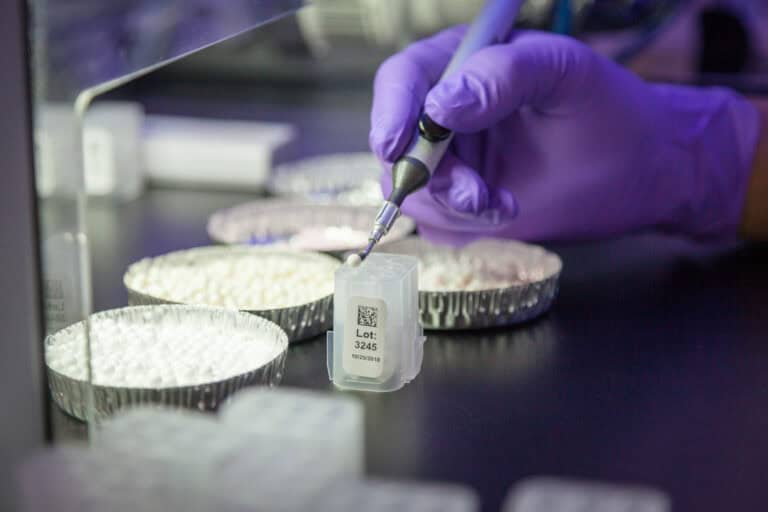Most research and development teams seeking to construct ambient products will encounter the challenges of protein lyophilization. A primary obstacle is enzyme and antibody instability outside of native conditions, as any processing for manufacturing risks loss of activity. However, traditional protein storage buffers contain glycerol, which is incompatible with protein lyophilization. Carriers may be added in order to facilitate protein lyophilization, but these often result in assay-killing interference. How can these obstacles to lyophilizing proteins be overcome?
Proteins can be difficult to lyophilize, but obstacles are almost always surmountable with the right formulation design.
Know Your Primary Protein Lyophilization Roadblocks
Kits containing proteins require careful handling and process optimization in comparison to those with only buffers, nucleotides, and consumables. When handled incorrectly, proteins can aggregate, denature, degrade, and ultimately lose activity. This is a major challenge for life science and molecular diagnostics companies as enzymes and antibodies are common components in kits.
To improve user experience, reduce cold chain shipping costs, and simplify logistics, companies are turning to lyophilization.
Since enzymes and antibodies are typically stored frozen, the kit will likely be split into multiple boxes to accommodate all storage conditions. Kits requiring cold chain shipping and storage have increased associated costs and complicated distribution logistics. Additionally, multiple boxes produce a poor end user experience. More boxes mean more storage locations to visit when setting up, more ice buckets at the bench, and more chances to accidentally misplace (or lose) a box. Since the antibody or enzyme component of a kit is often what forces -20⁰C storage, lyophilizing proteins can produce a room temperature-stable kit. To improve user experience, reduce cold chain shipping costs, and simplify logistics, companies are turning to lyophilization.
“Lyo-Ready” Proteins
Protein lyophilization has traditionally been plagued by complications. Freeze drying a sensitive antibody or enzyme can cause loss of activity if the process is not carefully designed and performed. The excipient (inert carrier added to facilitate lyophilization) chosen must not interfere with the assay’s function downstream. Additionally, most vendors supply proteins commercially in a glycerol buffer. Removing glycerol from this buffer is necessary to lyophilize the proteins, but many will not survive the lyophilization process still functional without cryoprotectant.
The excipient chosen must not interfere with the assay’s function downstream.
In response to these challenges, industry is attempting to streamline protein lyophilization. Many suppliers such as Integrated DNA Technologies, Empirical Bioscience, and Thermo Fisher have introduced “lyo-ready” versions of popular products that do not contain glycerol. R&D teams can design their kits to contain lyo-ready antibodies and enzymes from the start or can switch to comparable SKUs further down the development line. The breadth of available lyo-ready products is continuing to grow as more companies seek out ambient stability for cost savings and green initiatives.
Choosing the Right Formulation
Even when working with lyo-ready variants, proteins still require suitable excipient selection and environmental controls for lyophilization to succeed. A common challenge when attempting to lyophilize antibodies or enzymes occurs when the reconstituted protein does not perform at the same pre-lyophilization activity level. This can be caused by a number of factors, including damage during freezing, excipient interference, and pH differences. Strategic excipient selection is key to resolving these issues. Excipients should be screened both for lyophilization performance and functional assay interference before selecting a final formulation.
Excipients should be screened both for lyophilization performance and functional assay interference before selecting a final formulation.
Proteins can be difficult to lyophilize, but obstacles are almost always surmountable with the right formulation design. Similarly, other reagents once considered impossible or difficult are becoming easier to freeze dry. Argonaut has successfully lyophilized magnetic nanoparticles, latex formulations, antibody conjugates, and LAMP reagents. Many of these projects were brought to Argonaut after internal efforts or other suppliers had difficulties producing a quality-lyophilized product. An experienced lyophilization team is able to identify common pitfalls and design suitable excipient systems for more difficult projects.
With the right formulation strategies, protein lyophilization is no longer a roadblock to success.
As lyophilization continues to grow in popularity and accessibility, more companies will explore how to convert their cold chain-dependent proteins to ambient storage conditions. Difficult protein lyophilization targets like antibodies and enzymes will be encountered, but these are no longer as insurmountable as they were in the past. Regardless, in-house efforts and external contract service providers alike will both need to utilize informed design of excipient systems and suitable development screening to create functional and stable products. With the right formulation strategies, protein lyophilization is no longer a roadblock to success.
Have your protein lyophilization efforts hit an obstacle? Contact Argonaut to learn about our development and production services.


